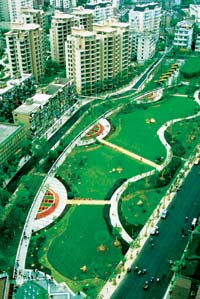Faced with the need to ensure clean air for the 2008 Olympic Games, Shougang's steel making days in Beijing were over and the blast furnaces moved out - together with other dirty industrial operations no longer considerable suitable for a modern international city, not to mention the nation's capital.

Beijing is not alone. Shanghai has spent years moving all its city-based factories out to satellite towns and beyond. Dalian, the key northeastern port, has put its heavy industrial past behind it, designating 134 factories, mostly state-owned, for removal, the bulk of which had already disappeared by the turn of the century.
Another success story is Benxi, a city of 1.2 million people in Liaoning province. The city was an industrial raw material base producing mainly iron and steel, coal, building materials and chemical products. About seven million tons of coal was burned in the city each year, so it was inevitable that a large amount of industrial waste spewed out of chimneys into the atmosphere. Added to this was the ring of mountains enclosing the city, which prevented the pollution from dispersing.
In the 1980s, the pall of pollution was so heavy and constant that environmental officials claimed Benxi had simply disappeared from satellite photographs taken from space. Benxi began to fight pollution in the late 1980s. Today, it lies within the 'sulfur dioxide control zone' designated by SEPA. Special regulations apply within this zone, and local officials are encouraged to experiment with innovative pollution control measures. Over the last decade, the city has invested US$60 million to reduce pollution - mostly end-of-pipe controls, which help tackle emissions as they are about to enter the atmosphere.
A more innovative approach is the adoption of a pilot scheme in emissions trading that has been successfully adopted in countries such as the U.S. The trading system applies to all industrial enterprises within the city, and covers sulfur dioxide, soot and industrial particulates. This scheme marks the first time that China has tried market-based pollution-control mechanisms.
Maximum permitted levels are set for five-year periods in conformity with provincial and national level plans. The local environmental agency then allocates emissions quotas among pollution sources within the city in the form of tradable emissions allowances. New, restructured or expanded industrial establishments must obtain emissions allowances before they can commence operations.
![]() 北京市通信公司提供网络带宽
北京市通信公司提供网络带宽
